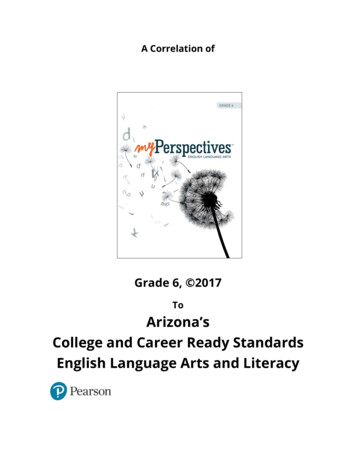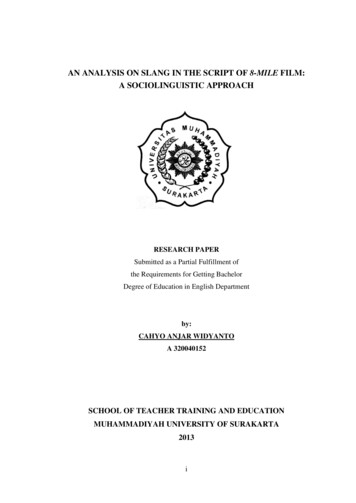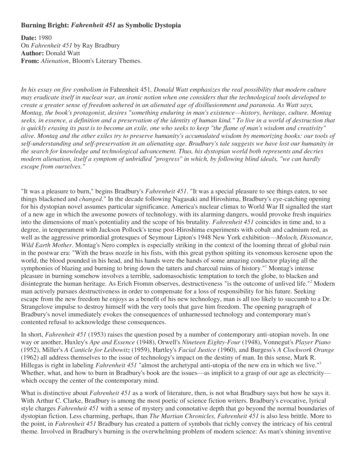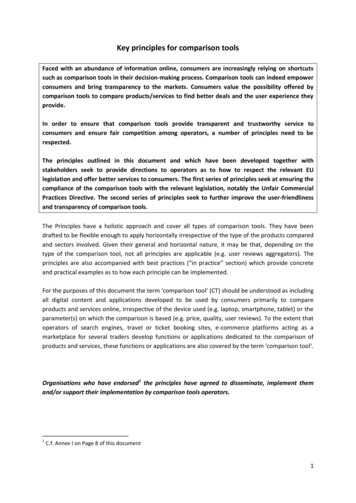
Transcription
International Journal on Studies in English Language and Literature (IJSELL)Volume 3, Issue 2, February 2015, PP 65-77ISSN 2347-3126 (Print) & ISSN 2347-3134 (Online)www.arcjournals.orgThe Comparison of Connotative Meaning in Animal Wordsbetween English and Persian Expressions and theirTranslationLeila AnjomshoaFirooz SadighiDepartment of Foreign LanguagesKerman Branch, Islamic Azad UniversityKerman, IranLeila.anjomshoa@gmail.comDepartment of Foreign LanguagesShiraz Branch, Islamic Azad UniversityShiraz, IranFiroozsadighi@/yahoo.comAbstract: Animal words and expressions have slowly become a significant member of the basicvocabulary of many languages in the world. Iranian and English are no exception. Some animal words inPersian and English are the same or similar in cultural connotations, because Iranian and the Englishpeople have some same capabilities of thought, some same laws of cognition, and some animals have thesame important role in the human life of these two nations, and have the same attributes and features. Butsome of them are dissimilar or different. The cause of it is that the English people and the Iranian peopleare different in religion, history, geographical environment, and customs and so on.The present study iswithin semantic – pragmatic framework. Over the years there has been an interest in research aboutmetaphors, idioms, and proverbs within different frameworks, but studies on animal expressions are few inboth Persian and English. This research is an attempt to show some lingual misunderstandings throughanimal expressions.Keywords: Animal expressions, connotations, English and Persian Expressions1. INTRODUCTIONIn the long history of human beings, animals are always closely related to our existence anddevelopment .Some are a kind of important food to people; some offer the labor for agriculture;some support the inspirations for some inventions of science and technology; and some are a kindof close friends of people, playing an important role in the mankind’s society.Fraser (1981)examined insulting animal expressions in different languages other than English to see if theyhave equal usages. Newmark (1988) believes that animal metaphors are used to a great extent inorder to describe inferior or undesirable human habits and attributes.Davids and Bentahila (1989) examined animal terms in British English and Moroccan Arabic.They use different theories like similarity and relevance to categorize animal metaphors. Holmes(1992as cited in Hsieh 2006) gives examples of the chicken metaphor in her sociolinguisticanalysis of sexism in language. Sutton (1995; cited in the same) studies linguistic discriminationagainst females and makes a strong argument about the metaphor "women are animals ".Tomita(2000) works on a large amount of rhetorical expressions such as animal similes and metaphorswhich are used to delineate the physical appearances or distinctive personalities of variouscharacters in Charles Dickens’s novels. Nadim (2000) examines animal roles in Shirazi proverbswith an approach to sociolinguistics. After analysing about 100 animal expressions, he concludesthat donkey expressions are the most frequent ones and have some salient semantic moleculessuch "crazy, worthless, and absurd". Hsieh (2001cited in the same) studies animal expressions inMandarin Chinese and German basedon Lakoff and Johnson’s conceptual metaphors(1980).Hsieh (2004cited in the same) further proposes that animal expressions are our vocabularyof values.Hsieh (2006) investigates animal expressions in Mandarin Chinese and German. With a focus oncat and tiger expressions, he reveals the salient semantic molecules of these animals in bothlanguages. In another study Hsieh (2oo8) compares animal and plant metaphors to show thesemantic autonomy of language and the cognitive level of using these metaphors in light of lay ARCPage 65
Leila Anjomshoa & Firooz Sadighiviews vs. scientific theories (Kövecses, 2000 as cited in Hsieh 2008) and verbal processes(Halliday, 1985 as cited in Hsieh 2008). He found that (1) metaphors are not scientific;(2) but theessence of metaphors and nature seems to overlap: in the natural world, animals are movingcreatures while plants are motionless life forms; (3) in our languages, animal metaphors are activeexpression whereas plant metaphors are static. Estaji and Nakhavali (2011) Studied SemanticDerogation in Persian Animal Proverbs. Their analysis shows that sex and semantic derogationare not shown in Persian structures and proverbs as much as other languages, but in the cases withsemantic derogation, the metaphorical meanings of the female proverbs connote worse qualitiesthan those connoted by the male proverbs.2. RESEARCH FRAMEWORKAn animal expression is defined in this study as any Persian or English expression that encodes atleast one animal name. Animal names are considered as metaphorical vehicles here, and most ofthe data are collected from the written English and Persian dictionaries of proverbs or idioms. Partof the raw data is taken from daily – life conversations.2.1. Animal Expressions and Semantic FeaturesIn this part first some of the semantic features of fox, camel, horse, snake and eagle expressionsare exemplified, and then discuss and compare the salient features of these animal names in bothEnglish and Persian.2.2. Fox Expressions and Salient Semantic FeaturesIn many cultures, the fox appears in folklore as a symbol of cunning and trickery, or as a familiaranimal possessed of magic powers.In Dagon mythology, the pale fox is the trickster god of the desert, who embodies chaos. The term"foxy" in English is defined as meaning - as the obvious "having the qualities of a fox" - also"attractive" and "sexy", as well as "red-haired.Overwhelmingly, cultural consensus on fox animal symbolism deals ernesswisdomThe fox encourages us to think outside of the box and use our intelligence in different, creativeways. The fox also brings us a message to try to approach our circumstances differently that wenormally would. Be aware of some of our habits, and try a different angle of action.The fox also a reminder that we must utilize all of our resources (seen and unseen) in order toaccomplish our goals. Sometimes this means calling upon some unorthodox methods.Furthermore, the fox is a sign to be mindful of our surroundings. Phenomenally effectiveshapeshifters and incredibly adaptable, the fox beckons us to not make too many waves but rather,adapt to our surroundings, blend into it, and use our surroundings (and circumstances) to ouradvantage.Other generalized fox symbolic meanings deal withfocusdeterminationright-actionfox: crazy like a foxfox: a sexually attractive womanfox :Informal: to perplex or confound: to fox a person with a problemfox: to cause (paper, wood, etc.) to become discoloured with spots, or (of paper, etc.) tobecome discoloured, as through mildew.International Journal on Studies in English Language and Literature (IJSELL)Page 66
The Comparison of Connotative Meaning in Animal Words between English and PersianExpressions and Their TranslationOut foxto trick; deceivesneaky as fox in the hen-houseIn Persian fox expressions may have these semantic features:Foxes when they cannot reach the grapes, say they are not ripeTry before you trustOne lie makes manyProvide against a rainy day Set not the fox to watch the geesesagacityA good swimmer often drownedtoo much cunning undoneThe bitter is sometimes bitBehind an able man there are always other noble menIf you deal with a fox, think of his trichks.If the lion’s skin cannot, the fox’s shallHe is as cunning as a fox2.3. Camel Expressions and Salient Semantic FeaturesCamels are symbols meaning both humility, willingness to serve and obstinacy. In medieval artand sculpture, the camel was used to represent humility and the willingness to bear another'sburden, largely because camels are trained to kneel down to receive heavy loads. Many artistsemploying this symbolism had no direct experience with camels. In the east, however, camels arefamous as being disagreeable and obstinate. An eastern proverb proclaims that the camel, "Cursesit its ancestors on the way up a hill and its Maker on the way down." For Egyptians, camels aresymbolic of complainers and those who are slow on their feet.International Journal on Studies in English Language and Literature (IJSELL)Page 67
Leila Anjomshoa & Firooz SadighiSome suggested keywords for symbolic camel yHumilityStaminaCAMELstrain at gnats and swallow camelsTo criticize other people for minor offences while ignoring major offenses.plain as the hump on a camelobviousstraw that broke the camel's backThe thing to push you over the edge.In Persian Camel expressions may have these semantic features:dog eat dogthe much coins, the much careBest is best cheapnothing so bold as a blind mareThe camel going to seek horns lost his earsIf you would wish the dog to follow you, feed himThe cat dreams of miceThe cats shuts his eyes while steals creamSay you saw me notPenny wise and pound foolishEveryone worships the rising sunInternational Journal on Studies in English Language and Literature (IJSELL)Page 68
The Comparison of Connotative Meaning in Animal Words between English and PersianExpressions and Their TranslationIt is a good beef that costs nothingTruth will come to lightThe end makes all equalCamel never sees its own hump:Flesh stands never so high but a dog will venture his legs2.4. Horse Expressions and Salient Semantic FeaturesThe horse is a symbol meaning willingness to work and independence. In ancient Rome, the horsewas clearly associated with death itself as it pulled the chariot of the sun god over the horizon intodarkness. In ancient Nordic art and religious ceremonies, the horse replaced the sacrificial bull ofMediterranean cultures. The horse signified resurrection from the dead to the Nordic peoples as itcarried the dead to the other side of life.A summary of prevalent symbol meanings for the horse:PowerGraceBeautyNobilityStrengthFreedomThe Horse symbol meanings of power are widespread through most cultures, and it is linked as anemblem of life-force. Many cultures assign the attributes of the four elements to the Horse: Earth,Fire, Air, and Water.as strong as a horse/ox- very strongas stubborn as a mule- very stubborn.back the wrong horse- to support someone or something that cannot or does not win or succeed.beat a dead horse- to continue fighting a battle that has been won, to continue to argue a point that has been settledInternational Journal on Studies in English Language and Literature (IJSELL)Page 69
Leila Anjomshoa & Firooz Sadighibet on the wrong horse- to misread the future, to not choose the winning person or solutionIn Persian horse expressions may have these semantic features:1- To eat like a horse:Straight from a horse's mouth:- To flog a dead horse:.A poor man wants something, a covetous man all thingMoney is not everythingWhat goes up , must come downLook not a gift horse in the mouthAs the work ,so the payBeauty is only skin deepNo work ,no moneyNo mill, no mealIf two men ride on a horse, one must behindYou cannot see the wood for the treesWhen you drink from the stream, remember the springNever make threats you cannot carry outEvery ass thinks himself worthy to stands with the king’s horsesWho has no horse may ride on a staffA crow does not pull out the eye of another crowInternational Journal on Studies in English Language and Literature (IJSELL)Page 70
The Comparison of Connotative Meaning in Animal Words between English and PersianExpressions and Their TranslationEvery ass thinks himself worthy to stand with the kings horsesdiligence2.5. Cow Expressions and Salient Semantic FeaturesIn many cultures the cow is symbolic of Mother Earth, and has been a symbol of fertility,nurturing, and power. This makes udder sense (pardon the pun), cows have been generous withtheir life force for eons. They are closely associated with provision and very earth-associated insymbolism.The cow is also a lunar symbol, aligning itself with feminine (yin) qualities (see list of yinattributes) among the Chinese yin-yang energies.A quick-list of Animal symbolism of the cow would include:PatienceNourishmentAbudanceFertilityFemale eginningsas awkward as a cow on roller skates- very awkwarda bull in a china shop- a tactless person who upsets others or upsets plans, a very clumsy persona cash cow- a product or service that makes much moneyhave a cow- to become very angry and upset about somethinghit the bulls-eye- to reach or focus on the main point of somethingHoly cow- used to express strong feelings of astonishment or pleasure or angera sacred cow- a person or thing that is never criticized or changed even if it should be (from a cow which issacred in India.International Journal on Studies in English Language and Literature (IJSELL)Page 71
Leila Anjomshoa & Firooz SadighiIn Persian Cow expressions may have these semantic features:Not know a B from a bull's footAs well-known as the village pumpIt is and endless task2.6. Snake Expressions and Salient Semantic FeaturesSnake symbolic meaning, overwhelmingly and in various cultures, deals with primordial life forceand usually turns our attention to gender supremacy (both male and female).Consequently, snakes span the symbolic bridge between lunar and solar associations as well asaspects between water and fire.Coiled within this polarity, we clearly see symbolism of duality and the search for balance. Othersnake symbolic meaning includes:International Journal on Studies in English Language and Literature (IJSELL)Page 72
The Comparison of Connotative Meaning in Animal Words between English and PersianExpressions and Their tectionSolemnityRejuvenationTransformationOccult (hidden) KnowledgeThe snake is a symbol meaning danger, charm and sexual energy (especially male). The snake isone of the oldest symbols, appearing repeatedly in the Bible as well as in the iconography ofEgypt and other ancient cultures. The snake is one of the Chinese astrological symbols. Thoseborn under the snake sign lead charmed lives, usually gain or inherit wealth and are seductive andattractive to others. They may be insecure or possessive but they know how to get things done.SNAKEsnake in the grass: There is trouble.if it was a snake it would have bit you :very close mad as a struck snake: cruel and angryonce a snake, always a snake :people do not change slippery as a snake :Tricky–unable to trustIn Persian Snake expressions may have these semantic features:Everything goes to him who does not want itTake the bad with the goodBetter be alone than in a bad companyInternational Journal on Studies in English Language and Literature (IJSELL)Page 73
Leila Anjomshoa & Firooz SadighiIt is good to strike the serpant’s head with your enemy’s handWhat is taken in with the milk, only goes with the soulOld foxes want no tutorsAn evil crow, an evil eggWhen you drink from the stream, remember the springTake the chestnuts out of the fire with the cat’s pawHe is like a snake in the grassIt is good to follow an old foxGod defense me from my friends; from my enemies I can defend myselfLittle birds pick at the dead lionDead men don’t biteThe devil looks after his ownHe has brought up a bird to pick out his own eyesNeither fish nor flesh nor good red herringThe bitter is sometimes bit3. RESULTS AND DISCUSSIONAs it is revealed in the table, fox, camel, horse, snake and cow evokes semantic features both inEnglish and some other languages than in Persian.Traditional notions show themselves in the form of proverbs. In other words, proverbs like otherlinguistic vehicles are the reflection of speakers’ views, cultures, believes social behaviors androles. So animal expressions can reveal the individual or social thoughts.Table1. The semantic features of some certain animals in Persian, English, and some other ishhorseEnglishsnakeEnglishcowSemantic featureCunning ,strategy, quick-thinkingAdaptability, cleverness ,wisdom, focus, determination, right-actionEndurance, Transport, Protection, Survival, Conservation, Journeying,Adaptive, Obedience, Temperance, Nobility, Humility, StaminaPower, Grace, Beauty, Nobility, Strength, FreedomCycles, Rebirth, Patience, Fertility, Eternity, BalanceCunning, Intuition, Awareness, Healing, Intellect, Protection,Solemnity, Rejuvenation, Transformation, Occult (hidden) KnowledgePatience, Nourishment, Abudance, Fertility, Female Power, Potential,Possibility, Calming, Grounded, Provision, BeginningsInternational Journal on Studies in English Language and Literature (IJSELL)Page 74
The Comparison of Connotative Meaning in Animal Words between English and PersianExpressions and Their TranslationFlesh stands never so high but a dog will venture his legsNo mill, no mealAs the work ,so the payInternational Journal on Studies in English Language and Literature (IJSELL)Page 75
Leila Anjomshoa & Firooz Sadighi4. CONCLUSIONThis paper analyses the connotations between the English and Persian animal words, andcompares the animal images and their connotations. We have learned that animal words have theirown features and cultural connotations in their own languages. Some of their culturalconnotations and images are the same, but most of them are different, and some even exist only intheir own language and make the vacancies between the two languages. These differences arecaused by religion, history, geographical environment, customs, and so on.We cannot always translate directly the animal words of the original from the source languageinto the target language. We must be well acquainted with the habits and environments of both thesource language and the target language before translating them into the target language, and tryour best to know the connotations carried by animal words. In the process of translation, weshould pay special attention to the cultural connotations of animal words of the two languages,keep objectivity of the original and shun subjectivity. Only in this way, can we translate properlyboth the real meaning and the style of the original from the source language into the targetlanguage.REFERENCESDavies, E. E., Bentahila, A., 1989. Familiar & less familiar metaphors. Language &communication 9, 49-68.Estaji,A. &Nakhavali.F. (2011). Semantic Derogation in Persian AnimalProverbs.Theory and Practice in Language Studies, Vol. 1, No. 9, pp. 1213-1217, September2011 , 2011 ACADEMY PUBLISHERFraser, B., 1981. Insulting problems in a second language. TESOL Quarterly 15, 435-441.Hsieh, shelly ching – you, (2006). A Corpus – based study on animal expressions inMondarinChinese and German. Journal of pragmatics 38, 2206-2222.Hsieh,Shelly ChingUu( 2008).“ Cognitive Models of Using Animal and PlantMetaphors”.NCKU FLLD Monograph Series Vol.1.Languages across Cultures. National Chengkung University.Qhanbari, Abdollah, (2001), Persian- English dictionary of proverbs, First pub., Rahnamapublication.Nadim, Mostafa, 2000, the role of animals in shirazi proverbs with sociolinguistic approach, Firstpub., First volume, Daneshgah publication.Newmark, Peter, 1988. Approaches to Translation. Prentice Hall, Hemel Hempstead-International Journal on Studies in English Language and Literature (IJSELL)Page 76
The Comparison of Connotative Meaning in Animal Words between English and PersianExpressions and Their Translation-AUTHORS’ BIOGRAPHYLeila Anjomshoa is an instructor at Islamic Azad University, Kerman, Iran. She has beenteaching English to EFL learners for about 10 years. She is a PhD candidate at Islamic AzadUniversity shiraz Branch now. Her field of interest is first and second language acquisition andcurriculum development.Firooz Sadighi is a professor of Linguistics at Islamic Azad University and Shiraz University. Hehas been teaching M.A. and PhD courses for many years. He has been graduated from IllinoisUniversity, Unites States. His Field of interest is linguistics, first and second languageacquisitions. He has published many worthy articles and books in the fields mentioned.International Journal on Studies in English Language and Literature (IJSELL)Page 77
2.3. Camel Expressions and Salient Semantic Features Camels are symbols meaning both humility, willingness to serve and obstinacy. In medieval art and sculpture, the camel was used to represent humility and the willingness to bear another's burden, largely because camels are trained to kneel down to receive heavy loads. Many artists










